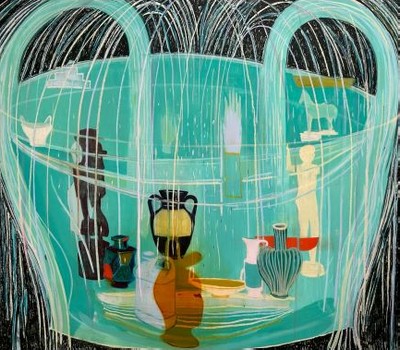Jules de Balincourt: Midnight Movers
Pace Gallery, New York
September 15 – October 28, 2023
Detail of new work by Jules de Balincourt, 2023
© Jules de Balincourt, courtesy Pace Gallery
Pace presents an exhibition of new paintings by JULES DE BALINBOURT at its 540 West 25th Street gallery in New York. This exhibition, titled Midnight Movers, marks the artist’s debut presentation with Pace in New York and his first solo show in the city in a decade.
Jules de Balincourt is known for his vibrant compositions imbued with mystery, ambiguity, and psychological import. Taking a singularly expressive approach to making, de Balincourt discovers his paintings as he paints them. In a process akin to abstraction, Jules de Balincourt’s paintings begin with pure form, gradually unfolding a unique mode of figuration. He eschews preparatory sketches in favor of an imaginative process guided by his own stream of consciousness. Despite their formal idiosyncrasies, his boldly and brightly hued works share a lyrical, oneiric quality that defies easy categorization—painting is let loose in service of discovering the medium’s pleasures and possibilities.
The artist’s work often examines the discordant and harmonious dynamics at play in the relationship between humanity and the natural world. In Jules de Balincourt’s hands, individual marks seem to dissolve and give way to layered effects and formal disturbances, which keep the eye in a state of constant motion. Figures are dissolved and disaggregated to the point of abstraction, coaxing bodies into landscapes and landscapes into bodies.
The surface of his work is almost always wood panel, a support that harkens back to the history of the medium in medieval and Renaissance Europe, and, in his intuitive approach to color, Jules de Balincourt draws on Fauvist and Expressionist predecessors. Yet the scenes he paints are unmistakably contemporary: artifacts that speak to the ways that the subconscious can reflect the social, political, and cultural conditions of an increasingly anxious and restless world, shaped by the forces of globalization and technology.
A sense of the nomadic and itinerant pervades Jules de Balincourt’s paintings. Figures seem suspended in the process of movement or displacement. A prevailing ambiguity underlies these moments of transit: are Jules de Balincourt’s figures in motion out of leisure or out of desperation? Are they partaking in a bucolic stroll or a long march, as if escaping from some unseen threat?
The themes of alienation, migration, and ambiguity, which cut through the works that is featured in Jules de Balincourt’s exhibition at Pace, are also echoed in the organization of the exhibition itself. Paintings of varying in sizes are placed in juxtaposition, creating spatial relationships that convey a sense of rhythmic interaction. The resulting installation plays a key role, inflecting viewers’ interpretations of each composition.
Jules de Balincourt’s mirage-like scenes and imagined dreamscapes are populated by mysterious personages and uncanny figurations. Spectral bodies and silhouettes dance throughout these unknown realms steeped in radiant color, where movement and form are liberated from ideology.
While Jules de Balincourt uses symbols and metaphors to describe the social and political circumstances in which he works, no single narrative underpins his paintings. Instead, the artist invites contemplation and interpretation, moving freely between varied subject matter and juxtaposing seemingly discordant themes. Often, references to contemporary life contrast with dreamlike scenes, as in the motif of fantasy castle colliding with images of the here- and-now, testifying to the flexible powers of painting as a mode of imaginative inquiry.
In many of Jules de Balincourt’s paintings, a sinister undertone pervades otherwise utopian settings. A nocturnal scene of a campsite nestled in a windswept forest reverberates with both yearning and foreboding, and, in another work, a unknown figures congregate according to strange logics in a bacchanalian gathering, conveying both threat and intrigue. Cutting across his work is a deep sensitivity to both the nuances of the human condition and the events and crises that inflect individuals’ experiences of the everyday.
With his body of new paintings, Jules de Balincourt constructs a tapestry of alternate realities that shadow our own, darkly reflecting the energies, longings, and sublimations in which the psychological fabric of daily life is woven.
JULES DE BALINBOURT (b. Paris, 1972) is known internationally for colorful, radiant paintings that meditate on the social, political, and cultural dynamics of an increasingly globalized world. Born in Paris in 1972, Jules de Balincourt spent most of his childhood years in California, and is currently based in Brooklyn, New York and Malpais, Costa Rica. The artist graduated from the California College of Arts and Crafts with a degree in Ceramics in 1998 and earned a Master of Fine Arts at Hunter College, New York in 2005. He later ran the Bushwick-based community and event center Starr Space from 2007 to 2010. In 2009, the artist’s work figured in the 10th Havana Biennial at the Museo Nacional de Bellas Artes. In 2021, Jules de Balincourt presented his first solo exhibition in Spain, titled After The Gold Rush, at the Centro de Arte Contemporáneo, Málaga. That show, which was curated by Helena Juncosa, featured a selection of works created by the artist in the last decade.
The artist has previously been the subject of solo exhibitions at the Kasseler Kunstverein, Kassel, Germany; the Montreal Museum of Fine Arts, Montreal, Canada; the Modern Art Museum of Fort Worth, Texas; the Mori Art Museum, Tokyo; and elsewhere. His work can be found in the collections of the Brooklyn Museum, New York; the Los Angeles County Museum of Art, California; the Modern Art Museum of Fort Worth, Texas; the Montreal Museum of Fine Arts, Canada; the Collezione Maramotti, Reggio Emilia, Italy; the Rochechouart Museum of Contemporary Art, France; and other institutions around the world.
PACE GALLERY
540 West 25th Street, New York City

